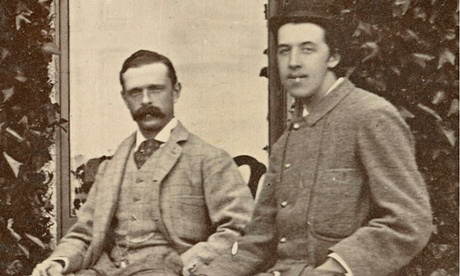
Dressed in tweed plus-fours, with a slightly wistful smile on his face, a young Oscar Wilde leans against the steps of Ashford Castle in 1878 in a previously unpublished photograph found in a family album.
Wilde was part of a shooting party October 1878 at Ashford Castle in County Mayo, Ireland. He was 23 at the time, and had studied at Oxford University for four years, earning a first-class degree in the “greats”. According to Frank Harris’s biography, in the Trinity term of 1878 Wilde won the Newdigate prize for English verse for his poem Ravenna Its recitation in the Sheldonian theatre that June “was the literary event of the year in Oxford”.
The photograph was found in a red Morocco album from the 1870s that had belonged to Lady Ardilaun, who is part of the Guinness family. The album, which also contains “numerous cartes-de-visite portraits, groups, houses and scenery”, is expected to fetch up to €8,000 (£6,200) at auction next month at Slane Castle, in County Meath, by Adam’s Auctioneers.
The photograph comes from an album of Guinness family photos and has never been published, according to Adam’s auctioneer Kieran O’Boyle. The photos were consigned by Ashford Castle and Lady Ardilaun.
In Wilde’s novel The Picture of Dorian Gray, published in 1891, Dorian attends a shooting party, where tragedy occurs. “After breakfast he walked with the Duchess for an hour in the garden, and then drove across the park to join the shooting party,” wrote Wilde. “The crisp frost lay like salt upon the grass. The sky was an inverted cup of blue metal. A thin film of ice bordered the flat reed-grown lake … The keen aromatic air, the brown and red lights that glimmered in the wood, the hoarse cries of the beaters ringing out from time to time, and the sharp snaps of the guns that followed, fascinated him, and filled him with a sense of delightful freedom.”
It doesn’t end well: “There was something in the animal’s grace of movement that strangely charmed Dorian Gray, and he cried out at once, ‘Don’t shoot it, Geoffrey. Let it live.’ What nonsense, Dorian!’ laughed his companion, and as the hare bounded into the thicket he fired. There were two cries heard, the cry of a hare in pain, which is dreadful, the cry of a man in agony, which is worse.”

